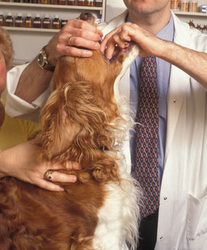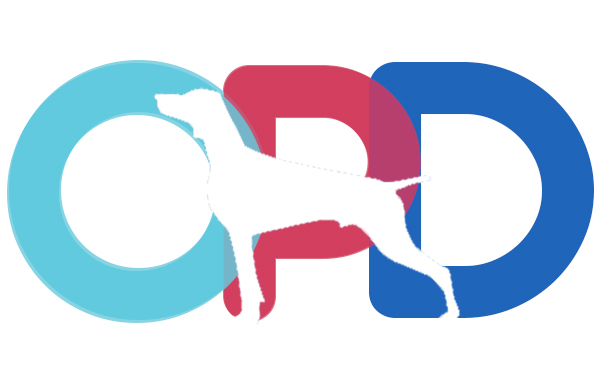When you’re home with the flu, all you want is good old fashioned in-bed care. Dog sick days require the same TLC! As loving parents to our furry friends, it is important that we are constantly aware of our dog’s physical and mental state. If something is off, we need to know what to check for and how to handle situations varying from a slight ear infection to a chronic internal infection.
Be prepared for home care for dog sick days…
- Advantages of home care
- Dog sick fix – Fasting
- If your dog won’t eat after fasting
- Herbal remedies
- How to give medication to your dog
- How to prepare a home remedy kit (on a separate page)
Advantages of Home Care – Dog Sick Days Under Control
Before considering whether or not you should care for your sick dog at home, it is important to consider whether or not your family situation will allow it. In other words, does your family have the time to provide adequate care for your dog?
If so, taking care of your dog at home has many advantages:
- The dog’s home, or den, is a familiar and comfortable place for them to be. They feel safe and free of stress in their own home unlike a busy, loud veterinary office or hospital. Feeling safe and comfortable can aide in the recuperation process.
- If your family has the time, excellent nursing care can be provided in the home.
- Strict control of the dog’s diet and nutrition is more likely to occur in the home, along with a clean and comfortable resting space.
- When you’re at your own home, you are in charge of the care. Dog sick care will be your choice entirely whether using holistic or conventional methods.
While there are many advantages to caring for your dog at home, there are obviously situations where superior care could be provided by a veterinarian.
Certain conditions that are very messy or life threatening can be handled much better at a prepared animal facility. If your dog has suffered a serious injury or is suffering from a disabling illness, it is always best to seek help immediately.
Fasting for a Sick Dog
So when is it appropriate for a sick dog to fast?
It is generally a good idea to encourage fasting for the first few days of an illness, especially if the dog is running a fever.
It is recommended that the dog fast until the fever is back to a normal temperature, which is less than 101.5°F (38.6°C).
And there’s no need to worry… making your dog fast is not some type of cruel punishment. In the wild, most animals will fast naturally in a cozy secluded place until their bodies have fought off the illness naturally.
Fasting helps the body to:
- Break down and get rid of older wastes that have accumulated in the liver and fatty tissues
- Unload the products of infections, abscesses and canine tumors
- Repair overworked cells, glands and organs
Before beginning a fasting period with your dog, call your veterinarian.
Dog sick time frames and the corresponding fasting can vary by the condition, and your vet will provide helpful recommendations.
See our Dog Fasting Guidelines for a general fasting schedule.
If Your Dog Won’t Eat After Fasting
There are situations where your dog will fast instinctively but will not subsequently regain her appetite.
An upset stomach, inflammation of digestive organs or toxic chemicals in the body or environment can cause this.
In the case of most healthy dogs that develop an illness and enter into a fast, they are able to fast for 3-5 days without loosing weight or developing weakness.
However, there are dogs that may enter into a fast and suffer rapid weight loss and weakness that robs them of essential energy needed to heal the body. In these extreme cases, it may be necessary to force your dog to eat. This is done by actually placing the food inside your dog’s mouth.
If your dog reaches an extreme case of weight loss and weakness and you want to attempt the force-feeding method, Dr. Pitcairn recommends the following pet puree:
Dr. Richard Pitcairn’s Pet Puree
- 2/3 cup raw chicken or turkey
- 1/3 cup half-and –half or whole milk
- ½ teaspoon bone meal
“Puree all the ingredients in a food processor. Adjust the liquid as needed to make a thick, smooth paste…refrigerate extras and save for up to three days…Feed ½ cup a day to small animals, proportionately more to larger ones. The easiest method is finger feeding… scoop a gob of this food paste on a finger and wipe it on the roof of your animal’s’s mouth, behind the front teeth.”
Herbal Care for Dog Sick Days
There are many cases in which herbal remedies can be used to aide a sick dog back to health.
See our Herbal Medicine for Dog Care page for more information.
How to Give Medication to Your Dog
Veterinarian prescribed medications are sometimes necessary (even for the most devout holistic and natural owners) for effective care. Dog sick time can be made more bearable and some medications will shorten their duration.
Medications come in liquid and pill or capsule forms, and each should be administered differently…
Liquid Medication
Dog experts recommend two different techniques for getting liquid medication into your dog.

- First, get your dog into a comfortable position and pry his mouth open with your hands. Lightly hold the upper jaw open with one hand and place your thumb and fingers in the gaps directly behind the fangs (for a small dog, only one finger is needed for this technique). After that, most dogs will relax their mouth. This should give you ample opportunity to pour the liquid in the mouth while tilting the dog’s head backwards so that the liquid slides down.
- Another option is to create a pouch out of your dog’s lip. Use one hand to pull out the side of the dog’s lower lip creating a little pouch where the liquid can then be poured. In order to induce swallowing, close the dog’s mouth with both hands and rub the sides of the throat.This will force the dog to swallow the liquid.
Pills and Capsules
Solid capsules and pills can be given to your dog quite simply by opening the mouth and placing the capsule on the back of the tongue, nearly down the throat.
After the capsule is inserted, close the dog’s mouth and rub the sides of the throat to induce swallowing.
This may take a few tries at first, but after a while your dog should be taking pills effortlessly.
If the pill is small and powdered, it can be wrapped in a piece of cheese or added to the dog’s favorite treat. That way the dog will never know they just took their medicine!
Do you believe in holistic pet care? If so, please tell your friends about us. Thank you for supporting our efforts!
